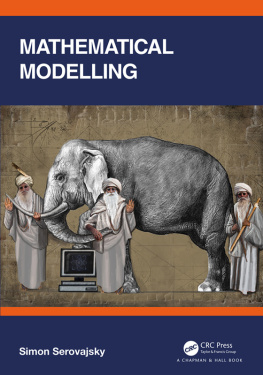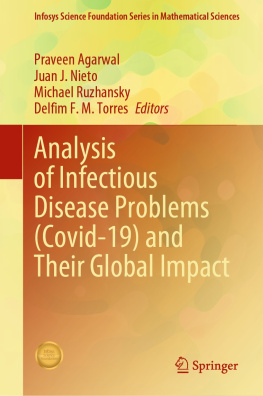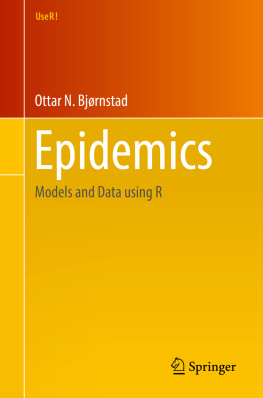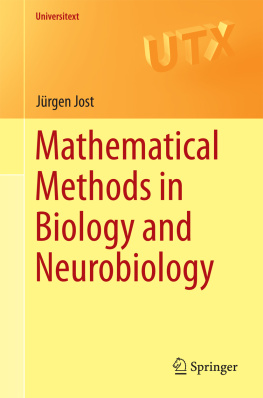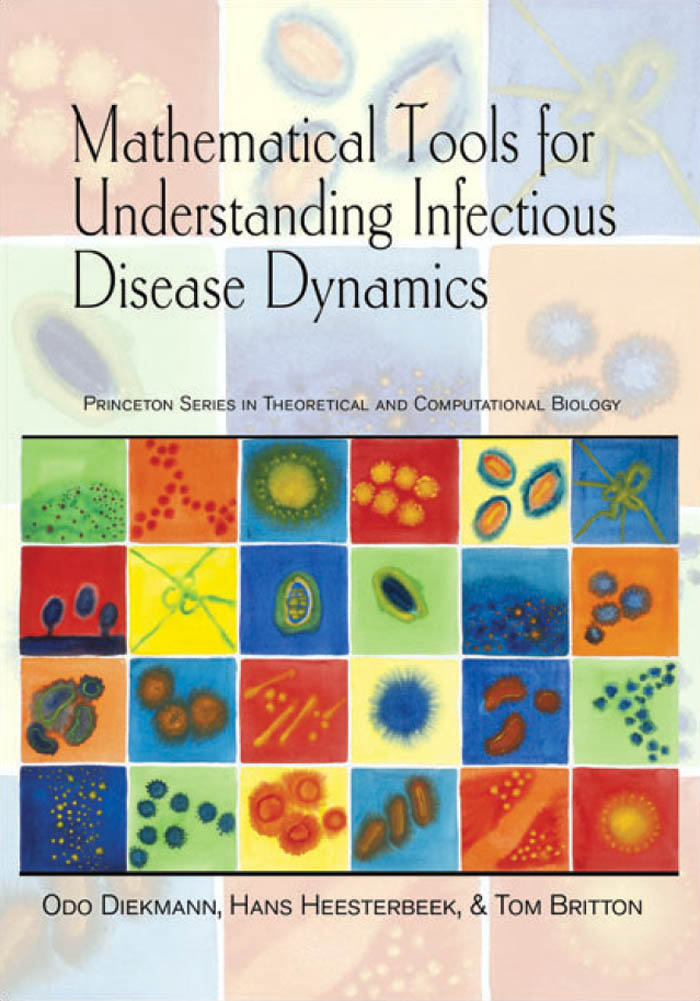Mathematical Tools for Understanding
Infectious Disease Dynamics
PRINCETON SERIES
IN THEORETICAL AND COMPUTATIONAL BIOLOGY
Series Editor, Simon A. Levin
Mathematical Tools for Understanding Infectious Disease Dynamics, by Odo Diekmann, Hans Heesterbeek, and Tom Britton
The Calculus of Selfishness,
by Karl Sigmund
The Geographic Spread of Infectious Diseases: Models and Applications, by Lisa Sattenspiel with contributions from Alun Lloyd
Theories of Population Variation in Genes and Genomes,
by Freddy Bugge Christiansen
Analysis of Evolutionary Processes,
by Fabio Dercole and Sergio Rinaldi
Mathematics in Population Biology,
by Horst R. Thieme
Individual-based Modeling and Ecology,
by Volker Grimm and Steven F. Railsback
Mathematical Tools for Understanding Infectious Disease Dynamics
Odo Diekmann, Hans Heesterbeek, and Tom Britton
PRINCETON UNIVERSITY PRESS
PRINCETON AND OXFORD
Copyright 2013 by Princeton University Press
Published by Princeton University Press
41 William Street, Princeton, New Jersey 08540
In the United Kingdom: Princeton University Press
6 Oxford Street, Woodstock, Oxfordshire, OX20 1TW
All Rights Reserved
Library of Congress Cataloging-in-Publication Data
Diekmann, O.
Mathematical tools for understanding infectious disease dynamics / Odo Diekmann, Hans Heesterbeek, and Tom Britton.
p. cm. (Princeton series in theoretical and computational biology)
Includes bibliographical references and index.
ISBN 978-0-691-15539-5 (hardback)
1. EpidemiologyMathematical modelsCongresses. 2. EpidemiologyMathematical models. 3. Communicable diseasesMathematical models. I. Heesterbeek, Hans, 1960-II. Britton, Tom. III. Title.
RA652.2.M3D54 2013
614.4dc23
2012012058
British Library Cataloging-in-Publication Data is available
This book has been composed in 
The publisher would like to acknowledge the authors of this volume for providing the camera-ready copy from which this book was printed.
Printed on acid-free paper.
press.princeton.edu
Printed in the United States of America
10 9 8 7 6 5 4 3 2 1
I simply wish that, in a matter which so closely concerns the well-being of the human race, no decision shall be made without all knowledge which a little analysis and calculation can provide.
Daniel Bernoulli, 1760, on smallpox inoculation
As a matter of fact all epidemiology, concerned as it is with variation of disease from time to time or from place to place, must be considered mathematically (...) and the mathematical method of treatment is really nothing but the application of careful reasoning to the problems at hand.
Sir Ronald Ross, 1911, The Prevention of Malaria
We shall end by establishing a new science. But first let you and me unlock the door and then anybody can go in who likes.
Sir Ronald Ross in a letter to A.G. McKendrick, 1911
Contents
Preface
This book builds on two previous books on the same topic by the same set of authors (plus one). We feel it is important, right from the start, to make clear how the new book and the old books are related. Both the previous books appeared more than 10 years ago: Mathematical Epidemiology of Infectious Diseases: model building, analysis and interpretation, Diekmann and Heesterbeek, John Wiley & Sons, 2000; and: Stochastic Epidemic Models and their Statistical Analysis, H. Andersson and Britton Springer-Verlag, 2000. The first took a textbook approach to predominantly deterministic modeling at least deterministic at the population level, but allowing for stochasticity at the level of individuals. The second had more a monograph-like approach to predominantly mathematical and statistical analysis of stochastic epidemic systems concentrating on analysis, rather than model building. The present book is based on these two earlier volumes, and in fact makes both of them obsolete. It replaces them with a textbook in the spirit of Diekmann and Heesterbeek, and the result is, in our (admittedly biased, but humble) opinion, more valuable than the sum of its parts. The new book integrates the deterministic and stochastic theory and approaches, rather than merely merging the old versions, treating both deterministic and stochastic modeling and analysis of infectious disease dynamics. New topics have been added, and for most topics already treated in one of the predecessors the text has been updated, or revised to improve exposition or integration.
We do not see our book as a mathematics monograph in the sense of instilling in the reader the beauty of the mathematical subject and prove theorems. The value of our book, in our view, is not in doing rigorous mathematics in theorem-proof style, and also not in highlighting deep problems from a mathematical point of view. The value of the book lies in showing how to be very precise in modeling phenomena in infectious disease dynamics, using mathematical reasoning and analysis. Mathematics is the tool, not the aim. We feel that for our aim the narrative style of doing mathematics is much more efficient in getting the message across. Our aim is to be very rigorous in the modeling. If we are being missionary at all, it is in trying to get across what (often hidden) assumptions lie behind choices and concepts in modeling, what the consequences are of these choices, and how superficially different concepts are related. The book is about translating assumptions concerning biological (behavioral, immunological, demographical, medical) aspects into mathematics, about mathematical analysis of certain classes of equations aided by interpretation, about inference from data (measurements, observations), and finally about the drawing of conclusions where results from the mathematical and statistical analysis are translated back into biology. We try to offer insight into the relation between assumed mechanisms at the individual level and the resulting phenomena at the population level, both for small and large populations, and the grey area that lies in between.
Some books offer wisdom. They can be read at leisure in an armchair near a fireplace, provided one pauses every now and then for contemplation. This is not such a book. This book has a zillion exercises and begs to be read with pencil and paper at hand (or perhaps, in a more modern way, using a computer with a program for symbolic manipulation). Some of the exercises one may want to read simply to see what statements they concern. This reading is essential, since usually the exercises are an integral part of the exposition. For many exercises, however, mere reading is not enough: one actually needs to do them. Learning to translate, model, analyze and interpret involves training. Some exercises are ridiculously simple since we have tried not to omit arguments or to tire the reader with details that interrupt the exposition too much; where other writers would state one easily sees or a simple argument shows, etc., we have inserted an exercise. Other exercises, however, are difficult and elaborate. Many exercises point the reader to caveats, pitfalls, and to similarities and differences in concepts. We anticipate that our readers will feel at times frustrated or even irritated. We therefore provide complete elaborations of all exercises, even of the ridiculously simple ones, as an integral part of the book. When a specific exercise seems beyond reach, we advise the reader to only glance at the elaboration as a kind of hint and then try again.


